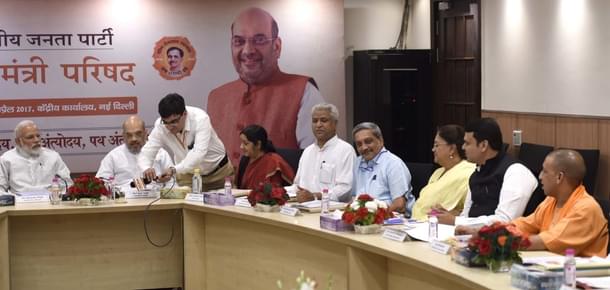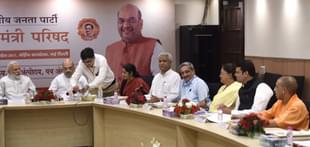Economy
Why Modi Must Push State Chief Ministers To Script India’s New Growth Story
Subodh Mathur
Oct 17, 2017, 01:05 PM | Updated 01:05 PM IST
Save & read from anywhere!
Bookmark stories for easy access on any device or the Swarajya app.


India’s economy has been growing rapidly for several years, with ups and downs. Last year, India was the world’s fastest growing economy. But, the economy has not given Indians the two things they want most: enough urban jobs and higher rural income.
India has suffered jobless growth. The country’s data on unemployment are unreliable, but we know that two years ago, more than 2 million people applied for 368 category IV peon jobs in Uttar Pradesh. More than 150,000 applicants had college degrees and over 250 had a PhD!
Because rural incomes are very low, Prime Minister Narendra Modi has had to continue with Mahatma Gandhi National Rural Employment Guarantee Act, although he had called it a symbol of United Progressive Alliance's misrule. Millions of farmers are trapped in un-repayable loans, and several chief ministers have been forced to waive their loans.
Modi is now facing heavy pressure to solve these problems. After all, he promised in his 2014 election campaign “acche din” for everyone.
Economists have been pressing Modi (and his predecessor) to reform land, labour and financial markets. These would help, but, Modi has ignored this advice, and shows no signs of changing his mind. Worse, economic growth has slowed down. Modi is looking at conventional ways to restore high growth. Good. But this will not create enough urban jobs, or raise rural income.
So, must India accept high unemployment and poor villagers?
No – there is an effective reform that Modi can implement now, which builds on his political power and administrative experience. Modi should push all of India’s 31 chief ministers to work hard to boost their states’ economies. He can particularly hammer hard the 13 Bharatiya Janata Party chief ministers.
This is arguably Modi’s most pressing doable economic reform today. Unlike Modi’s other schemes, such as demonetisation and goods and services tax, it will give benefits quickly without disrupting the economy.
Can chief ministers actually make a difference? Punjab’s history shows the economic damage that neglectful chief ministers do. Punjab became prosperous in the 1960s when the Indian government helped Punjabi farmers switch to high-yielding seeds. Then, successive chief ministers neglected the economy. Today, young Punjabis cannot get attractive jobs. They are so anxious to leave India that there is a thriving racket to smuggle them into Western countries. Many who stay behind have become drug addicts.
How can chief ministers create more jobs? They need to promote their small and medium enterprises, which employ most of India’s workers. These enterprises have the potential to create many more jobs. To realise this potential, chief ministers should act quickly to create conducive business environment for these firms and provide them with reliable power supplies.
Small businesses are currently constrained by bureaucracy and petty corruption. NITI Aayog, the government’s think tank, recently wrote, “reforms at the state level are as important as reforms by the union government. This is especially true of numerous clearances and filings which small and medium enterprises must comply with…” The reality is that inefficient and unresponsive local officials create hassles for these firms, and frequently demand bribes.
India’s unreliable power supplies also hinder the growth of small businesses because they cannot afford extensive back-up systems. The main source of unreliable supply is power distribution companies, which are mostly owned by Indian states. Years of excessive political interference by chief ministers have led to unmotivated managers, outdated networks and crippling debts.
The central government has launched Ujwal DISCOM Assurance Yojana, which is a bailout scheme that reduces the utilities’ debts, but does not impose any penalty for failure to improve their performance. Few of the chief ministers have shaken up their utilities’ management. Progress is slow – there is no sense of urgency. This must end.
Increasing rural income is more complex than promoting small and medium firms. Each state needs a custom scheme suited for its circumstances. Some states may need more than one scheme because they are large enough to have more than one geo-ecological zone. Apart from farming, chief ministers also have to stimulate non-farm income in villages.
These obstacles can be overcome without much effort. India has plenty of experts, qualified agencies, reports and recommendations. What chief ministers need to do is use these resources and work out schemes for their jurisdictions.
One more action is needed for India’s longer term economic growth: better health and educational facilities for ordinary Indians.
The medical facilities run by state governments provide an appalling quality of service. India’s child (0-5 years) mortality rate (CMR), a standard measure of a society’s health conditions is 47 deaths per thousand births. Bangladesh is at 38, Indonesia at 27 and Sri Lanka at 10. Several Indian states have low CMRs – press the other CMs to adapt their models.
Indian parents have no faith in state government schools. Enrollment in government schools fell by about 13 million over 2010-2015; private school went up by 17.5 million. Even the poor scrimp to send their children to private schools. Around two-thirds of children are still in government schools. It is the central government that has launched a programme, co-financed by international agencies, to upgrade primary schools. Now, Modi must press the chief ministers to do their share.
Overall, we need sound macroeconomic national policies to make the Indian economy grow rapidly. But, if Modi succeeds in pushing India’s chief ministers to perform, it will mean that India’s gross domestic product will rise with more jobs created and higher rural income than before. It’s this package that India needs now.
Subodh Mathur is Adjunct Professor, American University, Washington, USA.





